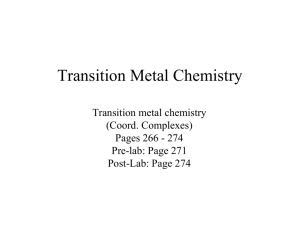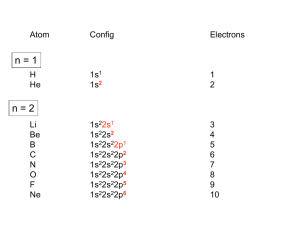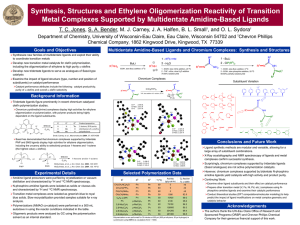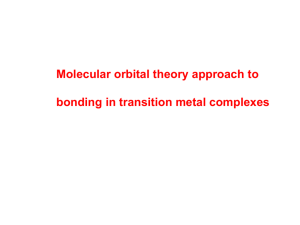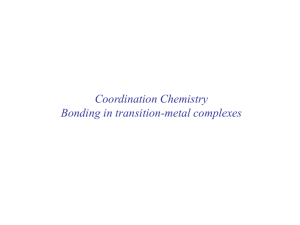Crystal Field Effects: Octahedral Complexes Lab Demo
advertisement
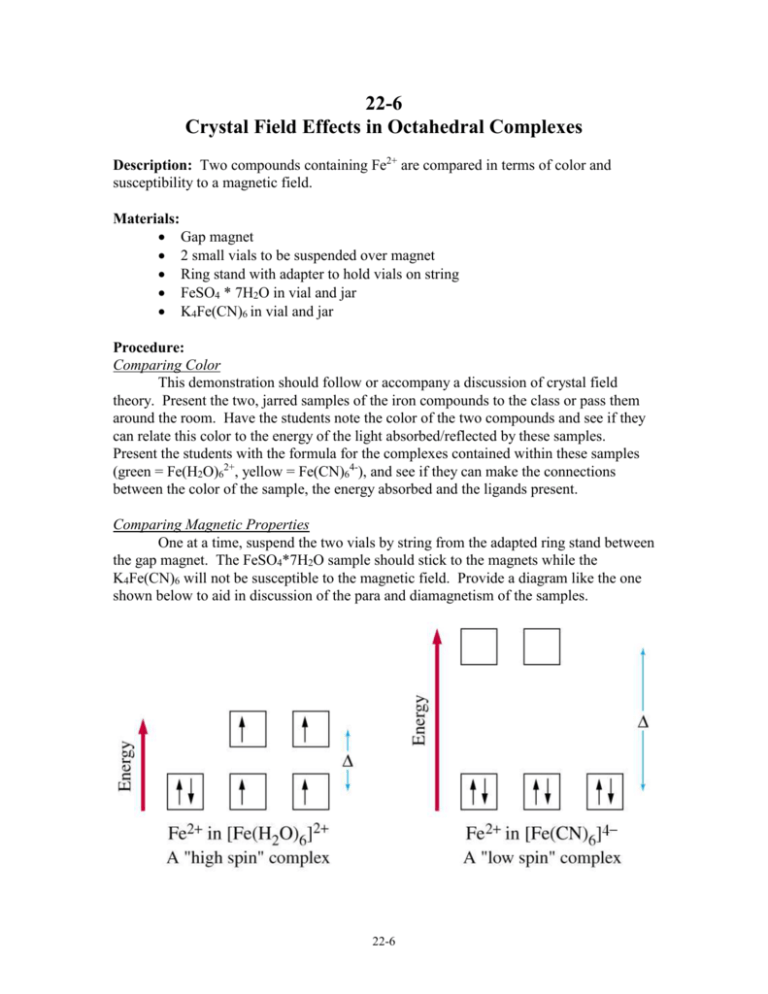
22-6 Crystal Field Effects in Octahedral Complexes Description: Two compounds containing Fe2+ are compared in terms of color and susceptibility to a magnetic field. Materials: Gap magnet 2 small vials to be suspended over magnet Ring stand with adapter to hold vials on string FeSO4 * 7H2O in vial and jar K4Fe(CN)6 in vial and jar Procedure: Comparing Color This demonstration should follow or accompany a discussion of crystal field theory. Present the two, jarred samples of the iron compounds to the class or pass them around the room. Have the students note the color of the two compounds and see if they can relate this color to the energy of the light absorbed/reflected by these samples. Present the students with the formula for the complexes contained within these samples (green = Fe(H2O)62+, yellow = Fe(CN)64-), and see if they can make the connections between the color of the sample, the energy absorbed and the ligands present. Comparing Magnetic Properties One at a time, suspend the two vials by string from the adapted ring stand between the gap magnet. The FeSO4*7H2O sample should stick to the magnets while the K4Fe(CN)6 will not be susceptible to the magnetic field. Provide a diagram like the one shown below to aid in discussion of the para and diamagnetism of the samples. 22-6 Concept: The shapes of the d orbitals are shown below. Crystal field splitting in octahedral complexes arises as a result of the electron density overlap between incoming ligands and the dz2 and dx2- y2 orbitals. This same overlap does not occur with the dxy, dxz and dyz orbitals, since these orbitals are not located along the axes. The result is a difference in energy values of the two sets of orbitals, referred to as the ∆o. Depending on the ligand(s) attached to the central atom, this ∆o can be relatively large or relatively small. We refer to ligands that result in a large ∆o values as “strong-field,” while those leading to smaller ∆o values are called “weak-field” ligands. 22-6 When visible light is absorbed, it results in electronic transitions between the three lower energy d orbitals and the two higher energy d orbitals. The wavelength of light absorbed, then, is directly related to the ∆o value of the complex in question. Therefore, strong-field ligands will lead to the absorbance of higher energy light than weak-field ligands. The Fe(H2O)62+ complex said to be present in the FeSO4 contains the weak-field ligand, water. The energy of the light absorbed is somewhere near red (lower energy) in the visible region, meaning that reflected green light is seen as the color of the crystals. The energy absorbed by the K4Fe(CN)6 is somewhere near violet (higher energy) in the visible region, meaning reflected yellow light is seen as the color. This is expected, since CN- is considered to be a strong-field ligand. Para and diamagnetism in complexes such as the Fe(H2O)62+ and K4Fe(CN)6 are considered to be a consequence of this d orbital splitting. When electrons fill the d orbitals, they tend to obey Hund’s rule by singly occupying an orbital before beginning to pair up. The exception to this is when such a complex contains a strong-field ligand. In these cases, the ∆o value may be so large that filling a lower energy orbital may be more energetically favorable than singly occupying a higher energy orbital first. Complexes containing strong-field ligands will more often than not be diamagnetic, while there are many cases where complexes containing weak field ligands are paramagnetic. 22-6


